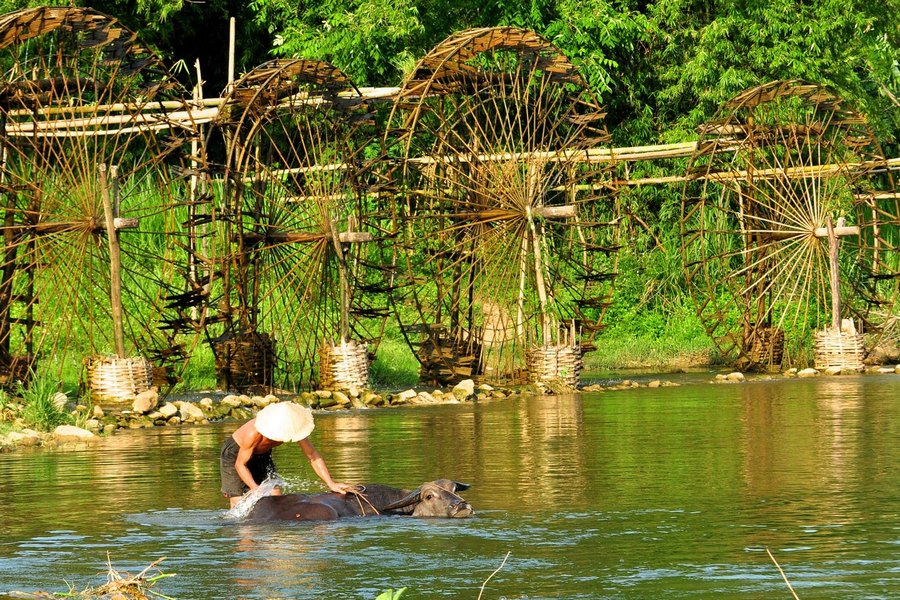
Here are some tips for anyone looking for shade from the heat, with summertime highs in many parts of Vietnam reaching up to 37 degrees Celsius.
Sa Pa

Sa Pa, a highlands vacation town in northern Lao Cai Province, is 1,600 meters above sea level and boasts a cool environment all year round.
You are most likely to have pleasant weather with average temperatures between 20 and 25 degrees Celsius throughout the months of June, July, August, and September. Sa Pa’s temperature lowers to 16 degrees Celsius, especially in the morning and after 5 o’clock, making it perfect for enjoying local specialties like fish hotpot and grilled skewers.
Those seeking relief from the intense summer heat could climb Fansipan, also known as “the Roof of Indochina,” which is located at a height of 3,134 meters (10,312 feet) and offers visitors temperatures of roughly 10 degrees Celsius.
Y Ty

The quaint and idyllic Y Ty Commune is about 70 kilometers from Sa Pa and has year-round cool weather, with average summertime highs of 23 degrees Celsius and lows of 17 to 18 degrees at night.
Y Ty, which is situated above 2,000 meters (6,600 feet) above sea level, enables you to physically touch and move through the clouds. On chilly days, clouds swoop down over the valleys and hamlets, bringing temperatures down to below 5 degrees Celsius.
Because of the clouds that cover Y Ty year-round and infrequently let sunlight through, it is known as “the Land of Fog.” The region is renowned for its narrow streets, serene valleys, stunning terraces, and modest, small ethnic homes.
Y Ty doesn’t yet have any hotels or resorts. However, some of the homestays in this area only charge roughly VND70,000 ($3) per night, including Wi-Fi, electricity, and tap water. It would be challenging to locate many tourism services in Y Ty because it is a rural commune that is still mired in poverty. There aren’t many eateries here.
Mau Son

Mau Son is located in Lang Son Province, more than one kilometer above sea level, and approximately 170 kilometers (106 miles) northeast of Hanoi. Here, visitors can experience all four seasons in one day: spring, summer, autumn, and winter.
The peak temperature in Mau Son during the summer is 27 degrees Celsius, however at night, guests can experience brisk weather as the mercury drops to 16. With numerous French-built villas and historic homes that have been abandoned, the mountainous hamlet was once a preferred destination for the top class of French people in Vietnam.
Although their populations are modest, the Dao, Tay, and Nung ethnic minorities are present in Mau Son. Every May and June, tourists to Mau Son have the opportunity to observe villagers growing rice on terraces that cling to anise forests. In addition to rice, villagers plant maize in their fields in the early summer, giving the area an entirely different appearance.
Hoang Su Phi

Visitors adore Hoang Su Phi, a mountainous area in the northern province of Ha Giang, for its crisp, cool climate, wild surroundings, and spectacular mountain vistas. Even at the height of summer, tourists can take advantage of the chilly air and watch the morning fog through the windows of stilt homes.
Hoang Su Phi experiences only a 21 degree Celsius nighttime low.
Over 50,000 people rely solely on the production of rice, with new crops being planted throughout the summer in anticipation of the harvest in September and October.
Tam Dao

Tam Dao, also known as “three islands” in Vietnamese, is a hill hamlet in the province of Vinh Phuc, about 90 kilometers from Hanoi, and one of the best locations for a summer retreat.
Ever since the French visited the region in the late 19th century, Tam Dao has become virtually a cliché in travel guides for weekend getaways in the city. Hanoians have also started to swarm there in order to get away from the chaos of city life. A sea of clouds and a labyrinth of undiscovered treasures can be found two hours from the capital.
Travel bloggers refer to Tam Dao as a “dreamy land” since the entire town is shrouded in clouds.
Tam Dao is now awash in homes, hotels, and even opulent resorts. Spend some time exploring a historic stone chapel that was constructed in 1912 by the French. It is positioned in a lovely, elevated elevation directly in the middle of the town, from where you can see the entire region.
Pu Luong

The 17,662 hectare Pu Luong National Reserve in Thanh Hoa Province, which is 130 kilometers northwest of Thanh Hoa Town and 160 kilometers south of Hanoi, features natural woods, falls, caverns, and mountains. There are tranquil Thai and Muong ethnic minority communities spread out around the region.
Even at the height of summer, with temperatures hovering above 20 degrees Celsius, the nature reserve’s location in the lowland limestone mountains and proximity to tropical woods ensures a consistently mild climate.
In Pu Luong, there are several lodging options, including hotels, resorts, hostels, and homestays. Since Pu Luong is a national reserve, all of the accommodations there adhere to ecotourism standards. As a result, standard amenities like air conditioning and private televisions are absent from hotel rooms.
Mooc Stream

Mooc Stream is a newly-emerging summer getaway location in the central province of Quang Binh. It is approximately 20 minutes by car from the renowned Phong Nha-Ke Bang National Park and is situated in a valley of limestone mountains in Phuc Trach Commune, Bo Trach District. People are drawn to plunge into the lake to escape the heat in the summer because the water is typically between 16 and 18 degrees Celsius.
Unlike well-known Nhat Le Beach or Son Doong, the largest and perhaps most stunning cave in the world, Mooc Stream has not yet been depicted on tourist maps. Take your pick from swimming, rope swinging, kayaking, rowing, or overnight camping to enjoy the outdoors at Mooc Stream.
Every day from early in the morning until 4:00 p.m., the stream is accessible. At lunchtime, guests can gorge themselves on grilled chicken, pork, sticky rice, and fried stream fish with rice balls. Since there are no chopsticks or drinking glasses available, visitors are given plastic gloves to use while eating.
Ba Na Hills

The Ba Na mountain range near Da Nang is referred to as the “climate pearl” and “green lung” of the central region. The French, who sought refuge from the summer heat in Ba Na Hills’ cold, mountain air, initially settled the area in the 1920s. Ba Na Hills is perched 1,487 meters above sea level on Chua Mountain. It is currently a well-liked tourist location for foggy summer hideaways because of the frigid climate and cool temperature.
Even though it is July, Ba Na Hills’ temperatures range from 17 to 23 degrees Celsius. With the 150-meter-long Golden Bridge gaining international reputation in recent years, tourism services have expanded to the hip town.
Bach Ma National Park

The weather at Bach Ma National Park, located in the central province of Thua Thien-Hue, is comparable to that of Tam Dao and Sa Pa due to its proximity to the sea, with summertime highs of 18 to 23 degrees Celsius. Foreign experts rate Bach Ma’s climate as one of the most pleasant in the nearby highlands, which are home to a lot of abandoned homes that once served as summer retreats for Hue’s upper-class families and colonial French officials. The highland resort was quickly forgotten after the French left Vietnam in 1954.
With a total area of 37,500 hectares, Bach Ma National Park is home to more than 2,300 plant and 1,700 animal species. In the forest, numerous species, including the red-shanked douc langur, sao la, white pheasant, Fujian cypress, and agarwood, need to be protected.
Visitors may experience the sensation of surfing the clouds as they travel the 20-kilometer route that leads to Bach Ma mountain’s 1,450-meter summit. The excursion always begins pleasantly with a drive up the mountain to Vong Hai Dai, a two-story roundhouse that serves as a lookout and rest break. A further five gorgeous lakes and waterfalls are passed on the walk.
Da Lat

Da Lat would be the top choice when searching for places to go to escape the summer heat. In a tropical nation like Vietnam, a village in the Central Highlands has a year-round cool environment that is unusual. During the colonial era, it served as a summer retreat for French officials who erected villas in the hills to avoid the heat and humidity of the lowlands.
The town is at its most ethereal from April to June when dense clouds and fog wrap mountaintops and valleys before dissipating in a dreamlike manner as the sun rises. Summertime temperatures range from 22 degrees Celsius during the day to 16 degrees Celsius at night.
The New York Times listed Da Lat as one of the world’s 52 must-see locations in 2016, while TripAdvisor users put it among the top 10 spots in Asia to watch.




